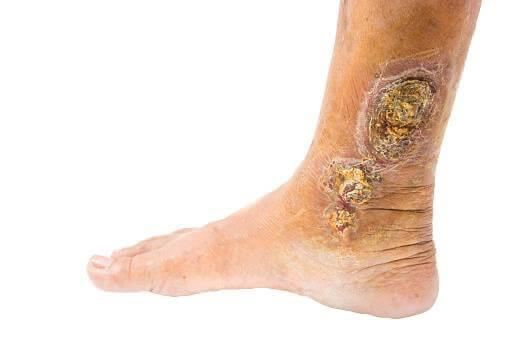Treatment of
arterial and venous ulcers
Treatment of
ulcers of vascular origin
Before you are prescribed treatment the underlying cause must be identified. Ulcers can be treated with appropriate care and antibiotics, but diagnosing the underlying cause can ensure that ulcers heal and do not recur.
Some conditions that contribute to ulcers include:
Diabetes
Deep vein thrombosis
Rheumatoid arthritis, lupus
Arterial disease
Chronic kidney disease
High blood pressure, high cholesterol
As with any ulcer, primary treatment focuses on increasing blood circulation to the affected area. Additional treatment goals include:
Pain reduction
Effective wound healing
Accelerating the recovery process
treatment of arterial ulcers
To treat arterial ulcers, your treating angiologist will try to restore circulation to the affected area. Treating the underlying cause with antibiotics may help reduce symptoms but will not cure the ulcer completely. Surgery may be needed to restore blood flow to tissues and organs in addition to antibiotics.
There are a number of surgical options to treat arterial ulcers, including angioplasty. This procedure uses a balloon to open the affected artery to improve blood flow. When blood flow is restored, your symptoms will disappear.
If blood flow cannot be restored or if the wound is severely infected, amputation may be necessary.
Arterial ulcers should be kept dry, clean and bandaged to prevent infection and not enlarge the wound. Discuss with a vascular specialist how often you should change your dressings and any additional recommendations for treatment or lifestyle changes.

treatment of
venous ulcers
Venous ulcers can take months to heal. In some rare cases they may never heal. Like arterial ulcers, treatment focuses on improving blood flow to the affected area.
Your angiologist may recommend antibiotics to treat the underlying cause, prevent infection and prevent recurrences. However, antibiotics alone cannot cure a venous ulcer.
Your doctor will show you how to properly clean and dress your wound. You will also be prescribed elasto-compressive therapy. This involves applying a compression bandage or sock to the affected area. The pressure from the compression improves blood flow and reduces symptoms.
You may be prescribed painkillers to reduce your discomfort. You also need to keep your legs elevated at every opportunity.
